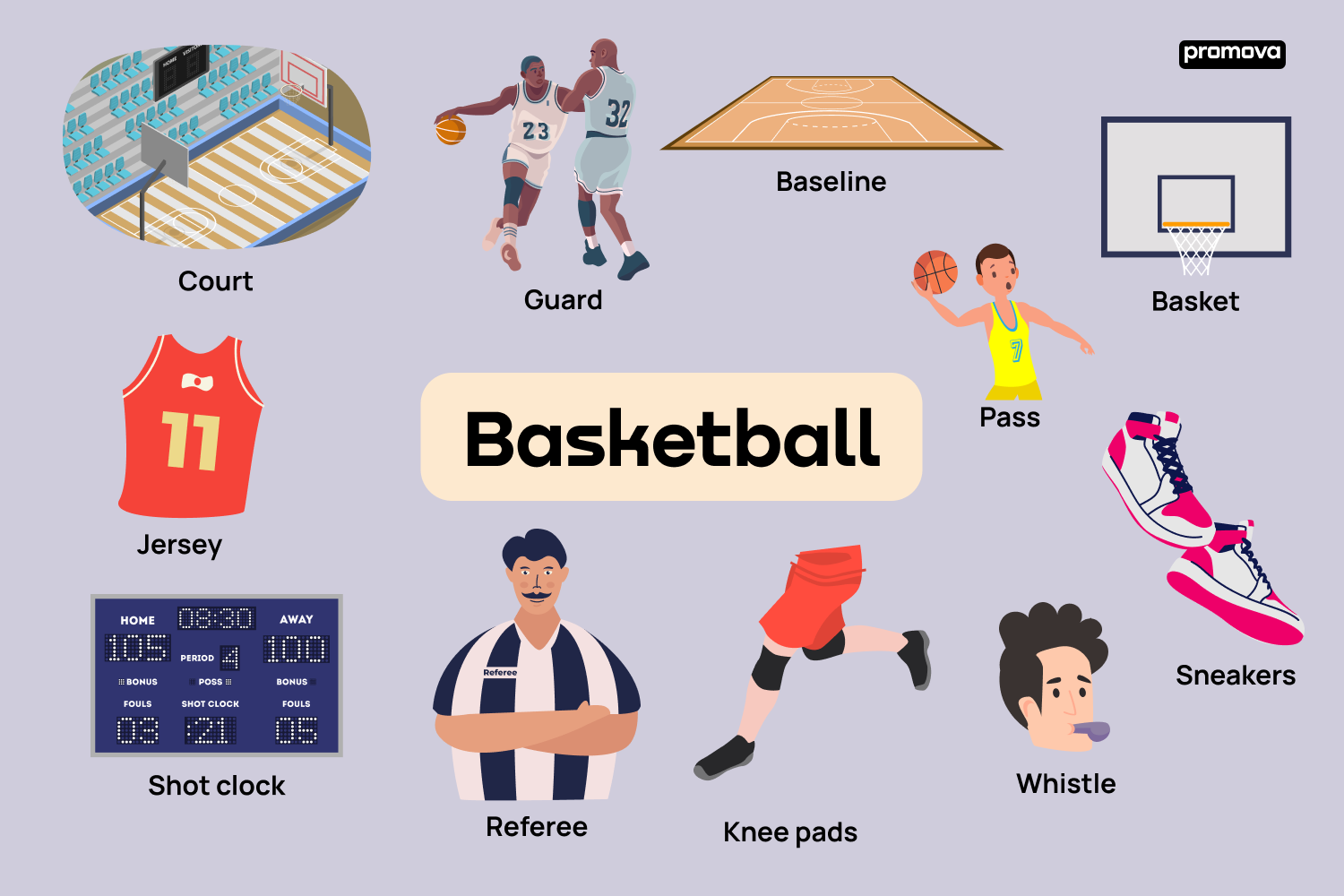There are hundreds of terms and phrases in basketball, but here’s our top 10 list that will elevate your expertise.
Basketball stands as one of the most widely embraced sports globally. Whether you engage in individual practice or join a team, it serves as an excellent means to stay physically active and unwind after a demanding day. Similar to all sports, basketball boasts a plethora of distinctive words and phrases that capture the essence of the game.
Acquiring this basketball vocabulary requires time and effort, regardless of whether you are a native speaker or an English learner. However, once you become familiar with the terminology, you’ll develop a more profound understanding of the sport, enabling you to connect with fellow fans and stay informed about the latest basketball developments.
This article will guide you through essential basketball vocabulary, empowering you to step onto the court with confidence. Additionally, we’ll explore effective ways to enhance your overall English proficiency, ensuring you’re well-prepared for any challenges the game may present. Keep reading to delve into the world of basketball terminology!
What is your English level?
Find out your A1 A2 B1 B2 C1 C2 level of English with our online test and receive your English certificate.
Basic basketball terms
To begin, let’s delve into the basketball terminology essential for articulating the most prevalent actions and occurrences in the sport. Mastering these terms will bring you closer to comprehending TV commentary, critiquing player performance, and engaging in discussions about game strategies with your team.
- Rebound
- Dribble
- Block
- Pass
- Shot

Basketball court terminology
Engaging in basketball while adhering to the rules and devising an effective game strategy with your team necessitates a solid grasp of basketball court terminology. If terms like baseline and center circle seem unfamiliar, there’s no need to worry – we’ve got you covered.
This list of basketball terms will ensure you know your way around the court:
- Free-throw line: Also recognized as the foul line, the free-throw line is positioned 4.57 meters away from the backboard and runs parallel to the baseline. It is utilized for free throws, providing players with an opportunity to score points without defensive interference after they’ve been fouled.
- Baseline: The baseline, alternatively known as the end line, designates the boundary lines situated at each end of the basketball court, positioned behind the baskets to mark the points where the court concludes.
- Center circle: The center circle, positioned at the middle of the basketball court, takes the form of a circular line. It serves the purpose of the tip-off, where one player from each team jumps for the ball to initiate the game.
- Sidelines: Sidelines refer to the boundary lines running along the sides of the basketball court, outlining the outer edges of the playing area. Players in possession of the ball must remain within the sidelines during gameplay.
- Three-point line: The three-point line, often referred to as the arc or perimeter, constitutes a line forming an arc-shaped boundary around the basketball court. In the NBA, it is situated 7.24 meters from the basket, and baskets made from beyond this line are valued at three points instead of two.
Defensive basketball terms
While focusing on scoring is natural, overlooking your defense can prove costly in a game. These five defensive basketball terms encapsulate essential strategic maneuvers to assist you in thwarting the opposing team:
- Steal, occurs when a defensive player gains possession of the ball from an opponent without committing a foul. This is typically achieved by intercepting a pass or dislodging the ball from the offensive player’s possession.
- A Press, or full-court press, is a strategy involving assertive pressure on the attacking team’s players as they attempt to bring the ball up the court. Defenders closely guard opposing players, seeking to induce turnovers and disrupt their gameplay.
- Man-to-man defense, also recognized as individual defense, is a tactic where each defensive player is assigned to guard a specific opponent closely. Their responsibility is to stay in proximity to their designated attacker, preventing them from finding openings and obstructing both shots and passes.
- Zone defense, on the other hand, revolves around defenders safeguarding specific areas or zones on the court rather than individual players. Their objective is to disrupt passing lanes, block shots, and force opponents into challenging positions within their designated zones.
- In a Trap, two defenders converge on an offensive player to create pressure and force a turnover. This usually occurs near the sidelines or in a court corner, with defenders collaborating to limit passing options, apply pressure, and induce mistakes.

Offensive basketball terms
Similar to many sports, basketball necessitates a careful equilibrium between offensive and defensive strategies. Successfully navigating through the opposing team’s defense to score demands exceptional collaboration and strategic gameplay.
These five offensive basketball terms aim to elucidate some of the widely utilized point-scoring techniques, steering your team towards a lead:
- Alley-oop, an exhilarating offensive maneuver, occurs when one player tosses a pass toward the basket, and another player catches it mid-air, executing a dunk or scoring before landing. Precision timing, coordination, and athleticism are imperative for a successful execution.
- Screen, also known as a pick, entails a player positioning themselves in the path of a defender to hinder their movement, creating an advantage for a teammate. The player setting the screen utilizes their body to obstruct the defender, freeing up their teammate for shots and passes.
- Cut signifies when an offensive player without the ball swiftly changes position on the court, making purposeful movements—often toward the basket or an open area—with the aim of receiving a pass.
- Pick-and-roll, alternatively termed screen-and-roll, involves one player setting a screen (pick) to enable their ball-handling teammate to evade the defender. Subsequently, the player who set the screen moves (rolls) toward the basket, making themselves available for a pass.
- Isolation, often referred to as iso, unfolds when a player engages in a one-on-one confrontation with a defender, with limited involvement from other teammates. Teammates clear out a section of the court, providing the player with space to maneuver and take their shot.
Are you C1 Advanced English?
Get your C1 Advanced English certificate now!
✓ Add your certificate to your resume
⭐ ⭐ ⭐ ⭐ ⭐
Basketball slang and jargon
Acquainting yourself with the official basketball vocabulary enhances your comprehension of tactics and technical aspects, but it may vary from the language spoken on the court. To actively participate in games and engage in conversations with fellow fans, it’s essential to be well-versed in the lingo.
You’ll come across the following basketball slang in nearly any game, whether it’s the NBA final, a corporate team-building event, or a casual competition on the local court:
- Hoop: The term hoop is a common synonym for the basketball rim or the entire basket, encompassing the net, rim, and backboard. People often use the expression “shoot some hoops” to refer to playing basketball.
- Brick: A brick is a shot attempt that hits the rim or backboard, usually indicating an unsuccessful and inaccurate shot. It leads to a “hard” rebound off the rim or backboard.
- Dunk: A dunk is a basketball shot where a player forcefully propels the ball into the basket using one or both hands. This typically happens when a player is in close proximity to the basket and jumps high enough to reach the rim.
- Swish: A swish occurs when a player successfully shoots the ball, and it enters the basket without making contact with the rim or backboard. The term is derived from the “swishing” sound produced when the ball hits the net.
- Airball: An airball takes place when a player attempts a shot, but the ball entirely misses the rim, net, and backboard. This results in the ball either going out of bounds or being retrieved by the opposing team without any contact.

Conclusion
Becoming acquainted with crucial basketball vocabulary extends beyond language proficiency. It enhances your comprehension of the sport’s rules, maneuvers, and strategies, ultimately contributing to your development as both a player and commentator.
We’ve explored fundamental vocabulary, encompassing various aspects of the court, offensive and defensive tactics, and basketball slang. Save this article for future reference, serving as your go-to glossary for basketball terms.
Feeling motivated? If you’re eager to continue advancing your English vocabulary, private lessons with a Preply tutor offer a swift path to progress. You can discover a tutor who aligns with your budget and schedule, and perhaps even shares your enthusiasm for the sport.
What is your English level?
Find out your A1 A2 B1 B2 C1 C2 level of English with our online test and receive your English certificate.


